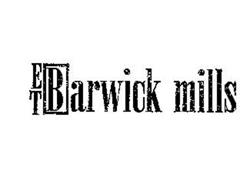Recently Burned Barwick Mill Historically Significant to Carpet Industry
LaFayette, GA, November 16, 2015—The E.T. Barwick plant in LaFayette, Georgia, currently used for storage, caught fire on November 14.
E.T. Barwick Mills was an early adapter of tufting at the time when the carpet industry started shifting from woven construction to tufted construction. Barwick Mills was also the first to make carpet with synthetic fibers.
The company was named for its founder Eugene Thomas Barwick, who was born November 23, 1913. After serving in the Coast Guard in World War II, Barwick began buying and selling tufted goods for Sears. The company first moved him to Chicago, Illinois, then to Atlanta, Georgia.
Barwick bought out one of his chief suppliers, McCarty Chenille of Chatsworth, Georgia. Barwick hired former owner Frank McCarty to continue to run the production end of the business, while he concentrated on sales. He logged more than 100,000 miles traveling selling his carpet in 1949 and returned with orders totaling $998,000.
Barwick’s sales doubled in 1950, and he began expanding his facilities. By 1954, the firm was producing 25% of all tufted floorcovering. Barwick Mills’ revenues topped $26 million that year. In addition to price advantage, tufted floor coverings offered color and styling variety.
In 1958, Barwick partnered with DuPont to introduce 501 nylon to consumers using a joint television ad campaign.
In 1963, Barwick Mills tapped public capital markets and became the first U.S. producers to purchase carpet printing equipment, and in 1967, it introduced a relatively successful line of printed carpet aimed at a new market kitchens.
Barwick sales for 1968 were $127 million. Despite all the new entrants into the tufted carpet industry, Barwick ended the 1960s as the largest producer, and the acknowledged leader in new product development.
ET Barwick was ranked 471 on the Fortune 500 list of America’s largest corporations in 1971 with $179 million in annual revenue. The company had two massive production facilities, one in LaFayette, Georgia and one in Dalton, Georgia.
Barwick dominated the carpet industry for more than 20 years. However, the company collapsed in the mid 80’s after years of several bad business deals, which included embezzlement by a few of the company’s executives.
In the midst of the financial chaos, Gene Barwick was forced out as CEO of Barwick Industries.
Barwick obtained new financing and managed to regain control of his company in the fall of 1978, but the company was too compromised to recover.
Barwick died in 1993.
Related Topics:Coverings
